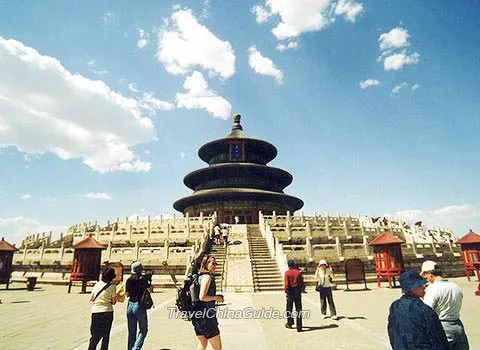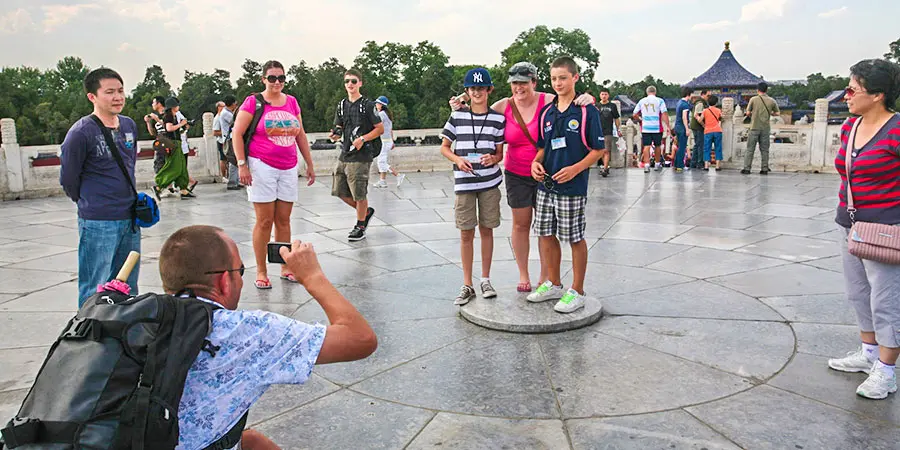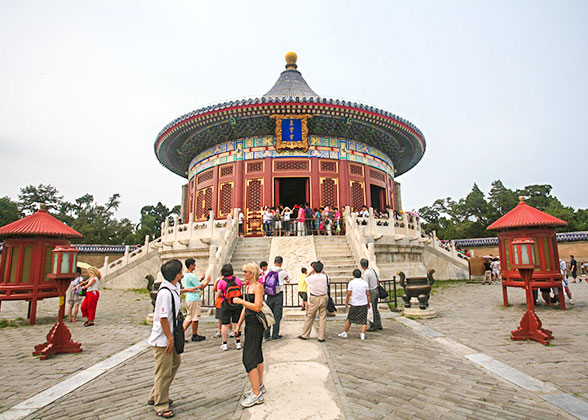In 1914, Yuan Shikai, then President of the Republic of China, performed a Ming prayer ceremony at the temple, as part of an effort to have himself declared Emperor of China.
The Temple of Heaven was inscribed as a UNESCO World Heritage Site in 1998 and was described as "a masterpiece of architecture and landscape design which simply and graphically illustrates a cosmogony of great importance for the evolution of one of the world’s great civilizations..." as the "symbolic layout and design of the Temple of Heaven had a profound influence on architecture and planning in the Far East over many centuries."
The Temple is enclosed with a long wall. The northern part within the wall is semicircular symbolizing the heavens and the southern part is square symbolizing the earth. The northern part is higher than the southern part. This design shows that the heaven is high and the earth is low and the design reflected an ancient Chinese thought of 'The heaven is round and the earth is square'.
The Temple is enclosed with a long wall. The northern part within the wall is semicircular symbolizing the heavens and the southern part is square symbolizing the earth. The northern part is higher than the southern part. This design shows that the heaven is high and the earth is low and the design reflected an ancient Chinese thought of 'The heaven is round and the earth is square'.
The Temple is divided by two enclosed walls into inner part and outer part. The main buildings of the Temple lie at the south and north ends of the middle axis line of the inner part. The most magnificent buildings are The Circular Mound Altar, Imperial Vault of Heaven and Hall of Prayer for Good Harvest from south to north. Also, there are some additional buildings like Three Echo Stones and Echo Wall.Almost all of the buildings are connected by a wide bridge called Vermilion Steps Bridge or called Sacred Way.
The Circular Altar has three layered terraces with white marble. During the Ming and Qing Dynasties (1368 A.D. - 1911 A.D.), the emperors would offer sacrifice to Heaven on the day of the Winter Solstice every year. This ceremony was to thank Heaven and hope everything would be good in the future. The Hall of Prayer for Good Harvest is a big palace with round roof and three layers of eaves. Inside the Hall are 28 huge posts. The four posts along the inner circle represent four seasons-spring, summer, autumn and winter; the 12 posts along the middle circle represent the 12 months; and 12 posts along the outer circle represent 12 Shichen (Shichen is a means of counting time in ancient China. One Shichen in the past equaled two hours and a whole day was divided into 12 Shichens). The roof is covered with black, yellow and green colored glaze representing the heavens, the earth and everything on earth. The Hall has a base named Altar for Grain Prayers which is made of three layers of white marble and has a height of six meters.
|
|
Another important building in Temple of Heaven is Imperial Vault of Heaven. If you look at it from far away, you will find that the Vault is like a blue umbrella with gold head. The structure of it is like that of Hall of Prayer for Good Harvest, but smaller in size. The structure was made of bricks and timber. The Vault was used to place memorial tablets of Gods. White marble railings surround the vault.
The Vermilion Steps Bridge connects the Hall of Prayer for Good Harvest and the Imperial Vault of Heaven. The south end of the Bridge is lower than its north end. The emperors in the past believed that they could go to heaven through this Bridge, which is why this bridge is also called Sacred Way. A Yu Route and a Wang Route are on two sides of the Sacred Way. The former one is only for the emperors to walk on and the later one is for the princes and the high officials to pass.
Three Echo Stones is outside of the gate of the Imperial Vault of Heaven. If you speak facing the Vault while standing on the first stone, you will hear one echo; standing on the second and then the third stone, you will hear two and three echoes respectively.
Three Echo Stones is outside of the gate of the Imperial Vault of Heaven. If you speak facing the Vault while standing on the first stone, you will hear one echo; standing on the second and then the third stone, you will hear two and three echoes respectively.
Another interesting and famous place for you to visit is called Echo Wall owning special feature. The wall encloses the Imperial Vault of Heaven. Its perimeter is 193 meters.
Another interesting and famous place for you to visit is called Echo Wall owning special feature. The wall encloses the Imperial Vault of Heaven. Its perimeter is 193 meters.
|
The Temple grounds cover 2.73 km² of parkland and comprises three main groups of constructions, all built according to strict philosophical requirements:
- The Hall of Prayer for Good Harvests is a magnificent triple-gabled circular building, 36 metres in diameter and 38 metres tall, built on three levels of marble stone base, where the Emperor prayed for good harvests. The building is completely wooden, with no nails.
- The Imperial Vault of Heaven is a single-gabled circular building, built on a single level of marble stone base. It is located south of the Hall of Prayer for Good Harvests and resembles it, but is smaller. It is surrounded by a smooth circular wall, the Echo Wall, that can transmit sounds over large distances. The Imperial Vault is connected to the Hall of Prayer by the Vermilion Steps Bridge, a 360 meter long raised walkway that slowly ascends from the Vault to the Hall of Prayer.
- The Circular Mound Altar is the altar proper, located south of the Imperial Vault of Heaven. It is an empty circular platform on three levels of marble stones, where the Emperor prayed for favorable weather. It was built in 1530 by the Jiajing Emperor and rebuilt in 1740.
In ancient China, the Emperor of China was regarded as the Son of Heaven, who administered earthly matters on behalf of, and representing, heavenly authority. To be seen to be showing respect to the source of his authority, in the form of sacrifices to heaven, was extremely important. The temple was built for these ceremonies, mostly comprising prayers for good harvests.
Twice a year the Emperor and all his retinue would move from the Forbidden city through Beijing to encamp within the complex, wearing special robes and abstaining from eating meat. No ordinary Chinese was allowed to view this procession or the following ceremony. In the temple complex the Emperor would personally pray to Heaven for good harvests. The highpoint of the ceremony at the winter solstice was performed by the Emperor on the Earthly Mount. The ceremony had to be perfectly completed; it was widely held that the smallest of mistakes would constitute a bad omen for the whole nation in the coming year.
Earth was represented by a square and Heaven by a circle; several features of the temple complex symbolize the connection of Heaven and Earth, of circle and square. The whole temple complex is surrounded by two cordons of walls; the outer wall has a taller, semi-circular northern end, representing Heaven, and a shorter, rectangular southern end, representing the Earth. Both the Hall of Prayer for Good Harvests and the Circular Mound Altar are round, each standing on a square yard, again representing Heaven and Earth.
The number nine represents the Emperor and is evident in the design of the Circular Mound Altar: a single round marmor plate is surrounded by a ring of nine plates, then a ring of 18 plates, and so on for a total of nine surrounding rings, the outermost having 9×9 plates.
The Hall of Prayer for Good Harvests has four inner, twelve middle and twelve outer pillars, representing the four seasons, twelve months and twelve traditional Chinese hours respectively. Combined together, the twelve middle and twelve outer pillars represent the traditional solar term.
All the buildings within the Temple have special dark blue roof tiles, representing the Heaven.
The Temple of Heaven was where the emperor came every winter solstice to worship Heaven and to solemnly pray for a good harvest. Since his rule was legitimized by a perceived mandate from Heaven, a bad harvest could be interpreted as his fall from Heaven's favor and threaten the stability of his reign. So, it was not without a measure of self-interest that the emperor fervently prayed for a very good crop.
In line with the Confucianist revival during the Ming dynasty, the sacred harvest ceremony was combined with the emperor's worship of his ancestors. This embellishment was also, in effect, self interest on the part of the emperor. For according to the Confucian pattern of social organization, just as the emperor respected his ancestors, so a younger brother should respect an elder brother, a wife her husband, a son his father, and a nation's subjects their ruler. Incorporating ancestor worship within the most solemn ceremony of the imperial ritual calendar, indirectly reinforced the social philosophy that perpetuated the emperor's power. The design of the Temple of Heaven complex, true to its sacred purpose, reflects the mystical cosmological laws believed to be central to the workings of the universe. Hence, complex numerological permutations operate within its design. For example, because the number nine was considered to be the most powerful digit, you will see that the slabs that form the Circular Altar have been lain in multiples of nine. Similarly within the Hall of Prayer for Good Harvest, the interior twenty-eight columns are divided into four central pillars to represent the seasons, twelve inner columns to represent the months and twelve outer columns to represent the two hour tranches that make up a day. There are many such examples of this intense numerology at play.
Although in imperial times commoners were not allowed to enter the enormous park, now for a minimal fee Chinese citizens can enjoy it all day long. Were you to visit at dawn you'd be surprised by the number of people there performing their morning exercises. Next to an older person practicing the slow and flowing movements of Tai Qi there might be a younger one performing vigorous karate-like punches and kicks. One group might be learning the ancient martial art of sword fighting, while another might be practising a traditional dance. Should you have the energy and the inclination, it is well worth waking up early one morning and visiting this park to watch such events take place.
Amongst Sir Isaac Newton's lesser known achievements in the seventeenth century was the design of a nail-less bridge at Queens College, Cambridge. I wonder how he'd have felt to have known that the Chinese had already built the Hall of Prayer for Good Harvest on the same principle two hundred years earlier.
Tips: Early morning is the best time to visit The Temple of Heaven. You will have an interesting experience watching local people doing morning exercises, like dancing, walking, practicing tai chi or playing games, as you walk to the temple.





